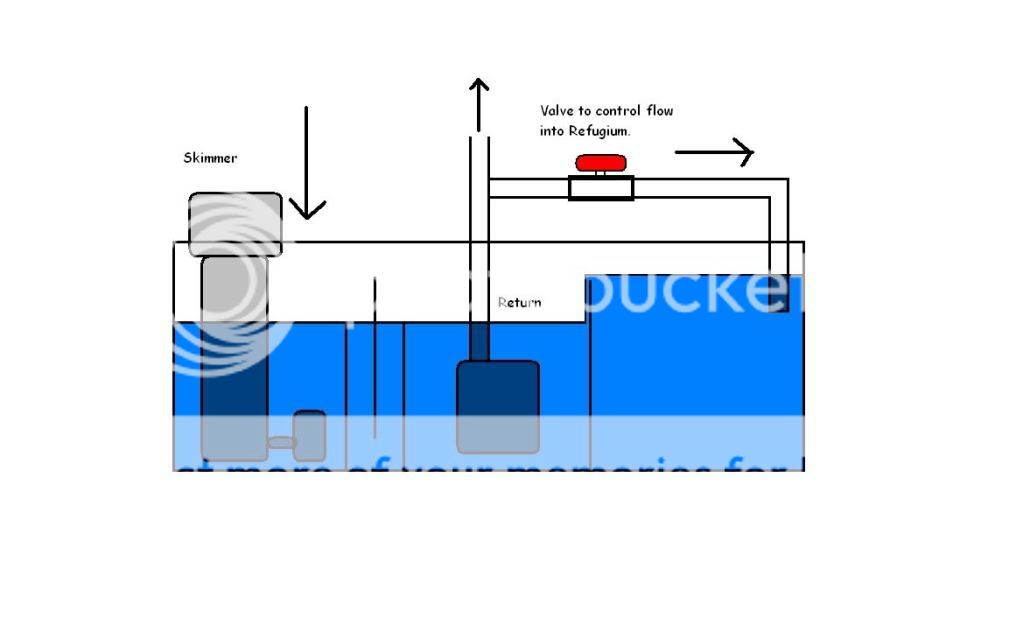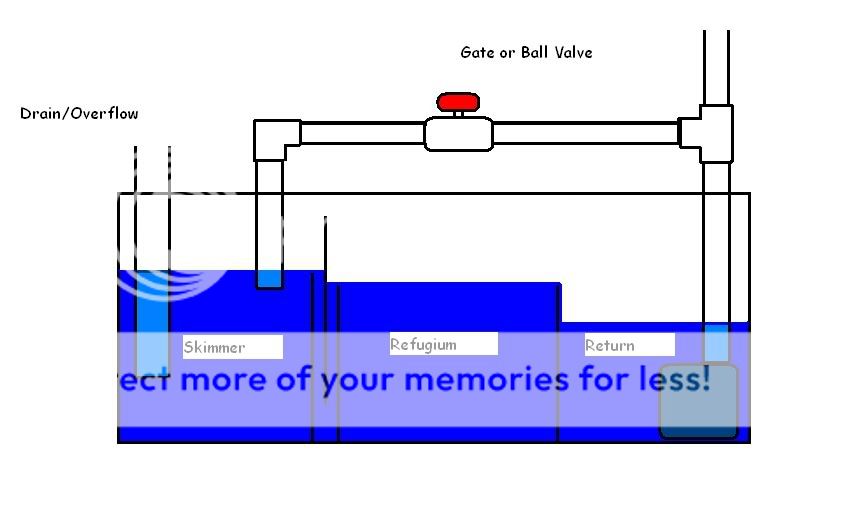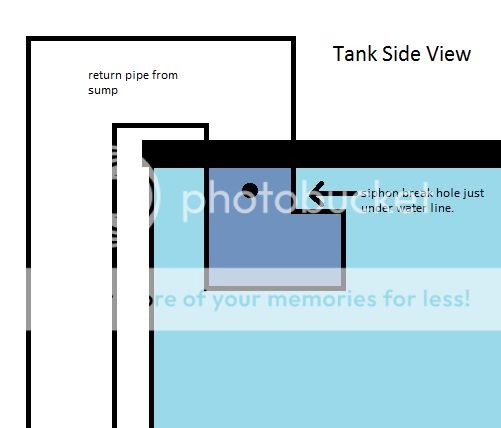Zissou
What about my dynamite?
Re: what is everything i need for a sump
You will need.
Baffles x 4, all the same height and width. If your sump is glass, get them cut at a glass shop. Measure the inside of your sump tank, and reduce the measurement by 1/4". Transfer measurement to cardboard panel, make sure the cardboard panel fits. If it doesn't, cut more. Once it can fit with about 1/8th of an inch on each side, take the measurement to the shop and have glass ones made. Height should be 10" to 12". This will give you room to adjust the standing height of your skimmer's water level. Oh, and when you make your bubble trap, set the middle baffle about 2" higher than the other baffles, as illustrated below. You can set the height, and width of the baffle chambers with cd cases, dvd cases, or an old book. I used an iphone 4 box.
Silicone sealant for baffles. Make sure you get the kind that's safe for aquariums. You want 100% silicone sealant with absolutely NO mold additives. The sealant you want is translucent. If it's white, you got the wrong stuff. You can find it at a hardware store, but you can also find it at petco; they'll make you pay extra because it's 'for aquariums'. But at least you'll be 100% sure it's safe.
Hang-off back, (HOB), Overflow. Depending on the size of your tank, a single pipe, 300gph would be fine for a small to medium tank. A dual pipe, 800gph for larger. Get braided, clear hose from the hardware store, (and the appropriate PVC connections and hose barb), and test for leaks.
1/4" clear or 'airline' tubing. Pick up several feet of this. You will use it to start your overflow, acclimate fish, start other siphons, etc.
A return pump. Get a pump that's slightly under your overflow rating. This will insure that your display tank doesn't overflow; a stronger pump would pump more water into your display faster than the overflow can take out. However, you might have to get a larger pump than your overflow, IF, your return pipe is too long, or you've split part of the return to go back into the sump. Eheim's are great pumps but expensive; Tunze pumps are getting great reviews and are more affordable. If you're on a budget, danner mag drive pumps are super reliable and cheap. They're a bit louder, and transfer more heat into the water, but this won't affect anything assuming your heater is set correct.
A protein skimmer. This will go in the first chamber of your sump. This insures it gets the worst stuff, and that anything living in your refugium or other chambers will not get killed before being pumped back into your display. (pods.)
This is what I prefer; the refugium gets lower flow this way and is a more peaceful area for pods. Not shown: the intake pipe going into the skimmer area:

This is more common, but water flows through the refugium area as fast as the return pump is pumping out. This may cause some turbulence Not shown: skimmer in first chamber.

VERY IMPORTANT:
On your RETURN pipe, where it dumps into your Display Tank, just under the water level, make two or three holes in the pipe, as a siphon break. You see, when you have a power outage, or when you shut off your return pump, the weight of the water in the return pump will be pulled down by gravity, causing a REVERSE SIPHON; water will now empty out of your display tank through the return pipe, potentially overflowing your sump. Having these holes drilled in the pipe, will insure that air will break the siphon, causing the reverse siphon to stop. ALWAYS check these holes and make sure they're clean every week. You want at least two holes, just in case a snail or other animal happens to be covering one when the power goes out. The overflow, on the other hand, does not need a siphon break, as it will be kept in stasis. When the power comes back on to the return pump, the overflow will restart it's siphon, once the water level of the display tank rises above the overflow teeth in the tank.

There are other types of overflows, but this is usually the most common beginner setup. If you're not afraid of drilling glass, you can look into a bean style overflow, or glass-holes overflow.
Easiest yet, buy a reef ready tank with built in overflows.
It's a lot easier than it sounds.
You will need.
Baffles x 4, all the same height and width. If your sump is glass, get them cut at a glass shop. Measure the inside of your sump tank, and reduce the measurement by 1/4". Transfer measurement to cardboard panel, make sure the cardboard panel fits. If it doesn't, cut more. Once it can fit with about 1/8th of an inch on each side, take the measurement to the shop and have glass ones made. Height should be 10" to 12". This will give you room to adjust the standing height of your skimmer's water level. Oh, and when you make your bubble trap, set the middle baffle about 2" higher than the other baffles, as illustrated below. You can set the height, and width of the baffle chambers with cd cases, dvd cases, or an old book. I used an iphone 4 box.
Silicone sealant for baffles. Make sure you get the kind that's safe for aquariums. You want 100% silicone sealant with absolutely NO mold additives. The sealant you want is translucent. If it's white, you got the wrong stuff. You can find it at a hardware store, but you can also find it at petco; they'll make you pay extra because it's 'for aquariums'. But at least you'll be 100% sure it's safe.
Hang-off back, (HOB), Overflow. Depending on the size of your tank, a single pipe, 300gph would be fine for a small to medium tank. A dual pipe, 800gph for larger. Get braided, clear hose from the hardware store, (and the appropriate PVC connections and hose barb), and test for leaks.
1/4" clear or 'airline' tubing. Pick up several feet of this. You will use it to start your overflow, acclimate fish, start other siphons, etc.
A return pump. Get a pump that's slightly under your overflow rating. This will insure that your display tank doesn't overflow; a stronger pump would pump more water into your display faster than the overflow can take out. However, you might have to get a larger pump than your overflow, IF, your return pipe is too long, or you've split part of the return to go back into the sump. Eheim's are great pumps but expensive; Tunze pumps are getting great reviews and are more affordable. If you're on a budget, danner mag drive pumps are super reliable and cheap. They're a bit louder, and transfer more heat into the water, but this won't affect anything assuming your heater is set correct.
A protein skimmer. This will go in the first chamber of your sump. This insures it gets the worst stuff, and that anything living in your refugium or other chambers will not get killed before being pumped back into your display. (pods.)
This is what I prefer; the refugium gets lower flow this way and is a more peaceful area for pods. Not shown: the intake pipe going into the skimmer area:

This is more common, but water flows through the refugium area as fast as the return pump is pumping out. This may cause some turbulence Not shown: skimmer in first chamber.

VERY IMPORTANT:
On your RETURN pipe, where it dumps into your Display Tank, just under the water level, make two or three holes in the pipe, as a siphon break. You see, when you have a power outage, or when you shut off your return pump, the weight of the water in the return pump will be pulled down by gravity, causing a REVERSE SIPHON; water will now empty out of your display tank through the return pipe, potentially overflowing your sump. Having these holes drilled in the pipe, will insure that air will break the siphon, causing the reverse siphon to stop. ALWAYS check these holes and make sure they're clean every week. You want at least two holes, just in case a snail or other animal happens to be covering one when the power goes out. The overflow, on the other hand, does not need a siphon break, as it will be kept in stasis. When the power comes back on to the return pump, the overflow will restart it's siphon, once the water level of the display tank rises above the overflow teeth in the tank.

There are other types of overflows, but this is usually the most common beginner setup. If you're not afraid of drilling glass, you can look into a bean style overflow, or glass-holes overflow.
Easiest yet, buy a reef ready tank with built in overflows.
It's a lot easier than it sounds.
